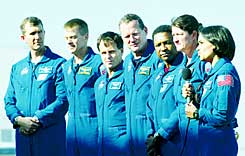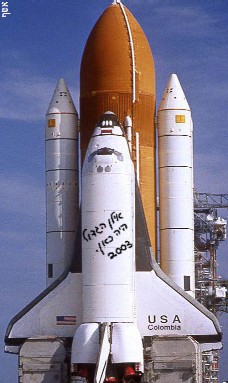Last month, a crack was discovered in the piping of the space probe Discovery. The crack was discovered in a metal ball with a diameter of about 6 centimeters located in the line of the oxygen pipe. The ball allows the tube to flex in the joints.

Space mission STS-107 (Ramon, third from left), yesterday
NASA said on Thursday that it will launch Columbia as planned next Thursday (16/1/03) for a scientific mission with the first Israeli astronaut on board. Depending on the solution to the recently found crack problem.
Last month, a crack was discovered in the piping of the space probe Discovery. The crack was discovered in a metal reactor with a diameter of about 6 centimeters located in the line of the oxygen pipe. The ball allows the tube to flex in the joints.
Engineers have spent the past month conducting experiments to test whether such a crack would weaken the fuel supply lines or cause metal particles to be sucked into the spacecraft's main engine during launch. More time is needed to complete the analyzes and they will report to Shuttle Program Manager Ron Ditmore on Sunday evening, just before the countdown begins.
Ditmore says that the crack in Discovery was caused by a defect in a ball that is an original part of the shuttle. "Whether it happened on the tenth flight, the 20th or the last flight - the 28th in Discovery's number, they don't know," he said.
"We are not in the range that this is the case in Colombia as well, and even if it is, is there a reason to stop the launch."
The 18 balls in the liquid oxygen and liquid hydrogen lines cannot be tested on the launch pad. Tests at Atlantis and Endeavor did not reveal any cracks.
Last summer, NASA shut down the entire fleet of shuttles after cracks were discovered in several types of tubes in all four shuttles.
Among the seven astronauts on the long-delayed flight was the first Israeli astronaut, Ilan Ramon.
NASA defines Ramon as a high-profile target. David Saliba, NASA's security officer and former secret agent, told the "Florida Hayom" reporter on Thursday that NASA adjusts its security arrangements for each launch.
The delay in Columbia's flight from July to January gave NASA more time to prepare for the possibility of a terrorist threat, but Saliva says all launches have been under heavy security since the attacks of September 11, 2001. "Time helped us, but it was not critical," he said. Saliva According to him, NASA made some changes and also backed up areas that were considered to have security deficiencies during the last launches.
He did not reveal how many security personnel will be on duty, although according to him NASA is working together with the Office of Homeland Security to ensure the safety of the shuttle. No specific threats regarding the scientific mission have been received so far. However, "we are always concerned about these missions because the shuttle is a prominent symbol of American technology" says Saliva.
events at launch
15.1.2003
 A picture that went around the internet today
A picture that went around the internet today
lThe "Chemical Garden" experiment goes into space - a delegation of "Ort Motzkin" students and a professor from the Technion went to Florida
A delegation of five students of "Ort" Motzkin by Yoni Netanyahu left for Florida, for the launch of the space shuttle with the first Israeli astronaut, Ilan Ramon. A unique experiment of theirs, called the "Chemical Garden", will be conducted on the ferry.
The students are accompanied by Professor Eli Kolodani from the Technion and their teacher, Dr. Amira Birnbaum. Upon their return, a ceremony will be held at the Technion, in which the experiment will be presented, which was conducted in collaboration with the Administration for Science and Technology at the Ministry of Education, headed by Yaffe Vigodatsky.
The experiment will test the crystallization of crystals in space, under conditions of no gravity. The students chose magnesium and calcium, which form blue and white crystals, the colors of the Israeli flag.
The students have been working on the experiment for about two years, under the guidance of Technion faculty members, Professor Koldani and Professor Yigal Komm, Dean of the Continuing Studies Unit. The Asher Space Research Institute, headed by Professor Moshe Gelman, coordinated the project in collaboration with the Israel Space Agency, headed by Avi Har-Evan.
Projection on a huge screen of the launch of the space shuttle Columbia!
The conference will be held on the day of the launch of the Israeli astronaut, Ilan Ramon, Thursday, January 16.1.2003, 16, at 45:XNUMX p.m.
In the Tau Auditorium (Faculty of Engineering) at Tel Aviv University
In the capacity of Minister of Education and Science - Ms. Limor Livnat
The event will be attended by students, scientists, engineers, science-seeking teenagers, space explorers and representatives of the Israeli space industries.
A new website from Senonit - a swallow in space
Address: http://www.snunit.k12.il/seder/space
The countdown has already begun and if everything goes as planned on January 16, 2003, Ilan Ramon, the first Israeli astronaut, will fly into space. Ilan Ramon will conduct experiments that are part of the MEIDEX project on the space shuttle. This project investigates the dust storms in the Middle East through photographs and observations of dust storms made by Ramon from space.
In honor of the event, Sanonit aired "Sanionit in Space"
This site is no longer a site that provides "dry" information about the solar system, the Earth and the space pioneers. Rather, it is a site full of games, activities and experiential tasks that make learning about space intriguing and "fun" for every surfer.
Among the activities you will find: a crossword puzzle about the solar system, the "Space Pioneers" spread and the "Navigate to Surf the Galaxy" which includes links to many websites about space in general and Ilan Ramon's flight in particular. You will be able to identify planets in the solar system based on "virtual postcards" sent by a "virtual" Swallow representative, decipher riddles with information about space, test your trivia knowledge about the Earth and its orbit, and more.
In addition to the activities mentioned - there is also a page with tasks for the young astronauts. There is a cluster of experiential educational activities designed for elementary school children.
More on the website: information from the magazine "Rosh Gadol" (a science monthly for young people) whose January issue also deals with Ilan Ramon's flight, various space research topics and more. Photos on the site courtesy of the American space agency NASA.
